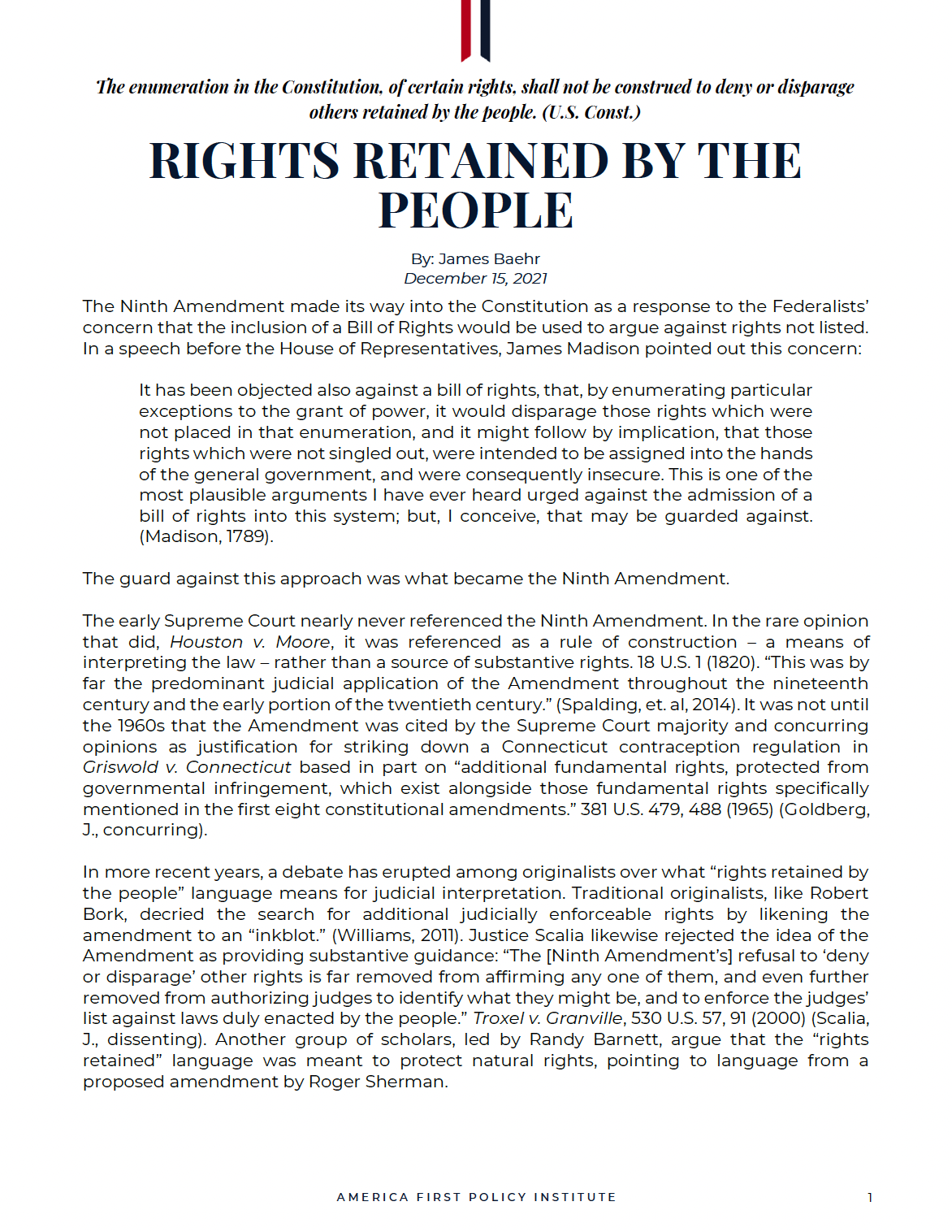Rights Retained by the People
The enumeration in the Constitution, of certain rights, shall not be construed to deny or disparage others retained by the people. (U.S. Const.)
The Ninth Amendment made its way into the Constitution as a response to the Federalists’ concern that the inclusion of a Bill of Rights would be used to argue against rights not listed. In a speech before the House of Representatives, James Madison pointed out this concern:
It has been objected also against a bill of rights, that, by enumerating particular exceptions to the grant of power, it would disparage those rights which were not placed in that enumeration, and it might follow by implication, that those rights which were not singled out, were intended to be assigned into the hands of the general government, and were consequently insecure. This is one of the most plausible arguments I have ever heard urged against the admission of a bill of rights into this system; but, I conceive, that may be guarded against. (Madison, 1789).
The guard against this approach was what became the Ninth Amendment.
The early Supreme Court nearly never referenced the Ninth Amendment. In the rare opinion that did, Houston v. Moore, it was referenced as a rule of construction – a means of interpreting the law – rather than a source of substantive rights. 18 U.S. 1 (1820). “This was by far the predominant judicial application of the Amendment throughout the nineteenth century and the early portion of the twentieth century.” (Spalding, et. al, 2014). It was not until the 1960s that the Amendment was cited by the Supreme Court majority and concurring opinions as justification for striking down a Connecticut contraception regulation in Griswold v. Connecticut based in part on “additional fundamental rights, protected from governmental infringement, which exist alongside those fundamental rights specifically mentioned in the first eight constitutional amendments.” 381 U.S. 479, 488 (1965) (Goldberg, J., concurring).
In more recent years, a debate has erupted among originalists over what “rights retained by the people” language means for judicial interpretation. Traditional originalists, like Robert Bork, decried the search for additional judicially enforceable rights by likening the amendment to an “inkblot.” (Williams, 2011). Justice Scalia likewise rejected the idea of the Amendment as providing substantive guidance: “The [Ninth Amendment’s] refusal to ‘deny or disparage’ other rights is far removed from affirming any one of them, and even further removed from authorizing judges to identify what they might be, and to enforce the judges’ list against laws duly enacted by the people.” Troxel v. Granville, 530 U.S. 57, 91 (2000) (Scalia, J., dissenting). Another group of scholars, led by Randy Barnett, argue that the “rights retained” language was meant to protect natural rights, pointing to language from a proposed amendment by Roger Sherman.
The people have certain natural rights which are retained by them when they enter into Society. Such are the rights of Conscience in matters of religion; of acquiring property and of pursuing happiness & Safety; of Speaking, writing and publishing their Sentiments with decency and freedom; of peaceably assembling to consult their common good, and of applying to Government by petition or remonstrance for redress of grievances. Of these rights therefore they Shall not be deprived by the Government of the United States. (Sherman, 1787).
Barnett argues that this passage shows the Founders’ commitment to individual natural rights – and that judges should enforce the Amendment by evaluating laws and regulations with a rebuttable “presumption of liberty” in mind. (Barnett, 2004). The current Supreme Court has not taken the opportunity to rule on what the Ninth Amendment means for unenumerated individual rights. With a wider array of originalists on the bench, the divide between those open to unenumerated natural rights (Justice Neil Gorsuch studied under renowned natural rights scholar John Finnis) and those committed to judicial restraint for unenumerated rights (in Justice Scalia’s vein) may make its way into future opinions. (Brugger, 2018).
AUTHOR BIOGRAPHY
James Baehr is a Senior Fellow of the America First Policy Institute. He is a Major in the Marine Corps Reserve and served as a Special Assistant to the President.
WORKS CITED
U.S. Const. amend. IX
Barnett, R. (2004). Restoring the lost Constitution: the presumption of liberty. Princeton University Press.
Brugger, C. (2018). Supreme Court Justice Neil Gorsuch: a natural law originalist. The Public Discourse. https://www.thepublicdiscourse.com/2018/09/39335/
Griswold v. Connecticut, 381 U.S. 479 (1965)
Madison, J. (1789). Annals of the House of Representatives. https://press-pubs.uchicago.edu/founders/documents/amendIXs7.html
Sherman, R. (1787). Roger Sherman Letter. https://www.consource.org/document/roger-sherman-to-___-1787-12-8/
Spalding, M. & Forte, D. (Eds.). (2014). The Heritage guide to the Constitution. Regnery Publishing.
Troxel v. Granville, 530 U.S. 57 (2000)
Williams, R. (2011). The Ninth Amendment as a rule of construction. Columbia Law Review, 498-573. https://www.jstor.org/stable/29777203
